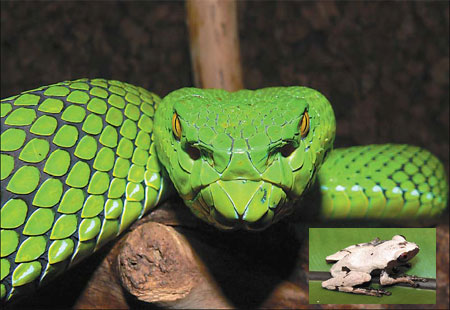Scientists have discovered more than 1,000 species in Southeast Asia's Greater Mekong region in the past decade, including a spider as big as a dinner plate, the World Wildlife Fund said yesterday.
 |
|
The World Wildlife Fund Greater Mekong Program yesterday released these pictures that show a Gumprechts green pitviper (above) and a Theloderma licin (inset), both found in Thailand. Scientists have discovered more than 1,000 new species in the Mekong region of Southeast Asia in the last decade, including a spider as big as a dinner plate. [Chinadaily.com.cn] |
A rat thought to have become extinct 11 million years ago and a cyanide-laced, shocking pink millipede were among creatures found in what the group called a "biological treasure trove".
The species were all found in the rainforests and wetlands along the Mekong River, which flows through Cambodia, Laos, Myanmar, Thailand, Vietnam and the southern Chinese province of Yunnan.
"It doesn't get any better than this," Stuart Chapman, director of WWF's Greater Mekong Program, was quoted as saying in a statement by the group.
"We thought discoveries of this scale were confined to the history books."
The WWF report, First Contact in the Greater Mekong, said that "between 1997 and 2007, at least 1,068 have been officially described by science as being newly discovered species."
These included the world's largest huntsman spider, with a leg span of 30 centimeters (11.8 inches), and the "startlingly" colored "dragon millipede", which produces the deadly compound cyanide.
Not all species were found hiding in remote jungles - the Laotian rock rat, which the study said was thought to be extinct about 11 million years ago, was first encountered by scientists in a local food market in 2005, it said.
One species of pitviper was first noted by scientists after it was found in the rafters of a restaurant at the headquarters of Thailand's Khao Yai national park in 2001.
"This region is like what I read about as a child in the stories of Charles Darwin," said Dr Thomas Ziegler, curator at the Cologne Zoo, who was involved in the research.
"It is a great feeling being in an unexplored area and to document its biodiversity for the first time both enigmatic and beautiful," he said.
The new species highlighted in the report include 519 plants, 279 fish, 88 frogs, 88 spiders, 46 lizards, 22 snakes, 15 mammals, 4 birds, 4 turtles, two salamanders and a toad - an average of two previously undiscovered species a week for the past 10 years.
The report warned, however, that many of the species could be at risk from development, and called for a cross-border agreement between the countries in the Greater Mekong area to protect it.
(China Daily December 16, 2008)